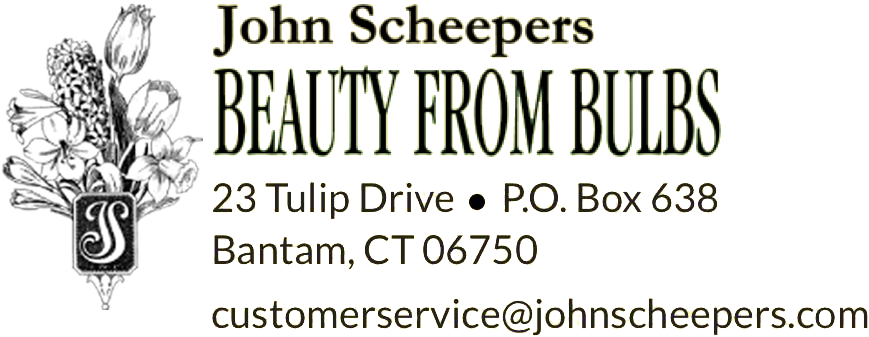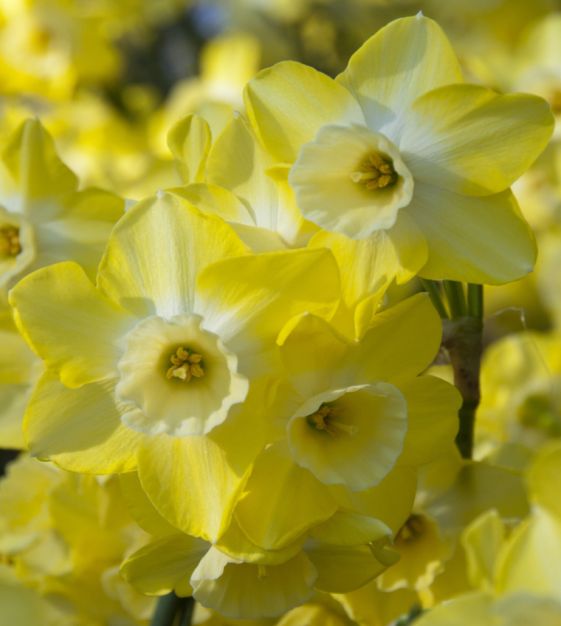-
- 20%-Off Website Specials
- New for 2024!
- Tulips
- Narcissi
- Allium
- Anemone blanda
- Brodiaea
- Camassia
- Chionodoxa
- Corydalis
- Crocus
- Eranthis
- Eremurus
- Erythronium
- Fritillaria
- Galanthus
- Geranium
- Gladiolus
- Hyacinths
- Hyacinthoides
- Ipheion uniflorum
- Dutch Iris
- Rock Garden Iris
- Ixiolirion
- Leucojum Aestivum
- Muscari
- Ornithogalum
- Oxalis
- Puschkinia
- Scilla
- Lilies
- Peonies
- Tender Bulbs
- Anemone Giants
- Tecolote Ranunculus
- Freesias
- Paperwhites
- Amaryllis
Narcissus Regeneration
(7 YYW-W) A 1995 floriferous Richard and Elise Havens hybrid, this award-winner yields four to five 2.5” flowers per stem. Deer- and rodent-resistant, it looks like bouquets in the garden. It is vivid lemon-yellow with a high contrast white halo around the base of its bowl-shaped, wavy-edged lemon cup. Its Hillstar ancestry is apparent as the dainty cup matures to creamy-white. Later flowering and scented. Narcissus Class: Jonquilla (Royal Horticultural Society Division 7). Bulb size: 12/14 cm. Bloom time: April/May. Horticultural zones 5-9. Plant 6" to 8" deep and 6" apart. Height: 16".
Narcissi are The Art & Soul of Spring.
Narcissus Horticultural Tips Narcissus Forcing Tips
- Information
Jonquilla Narcissi
All sweetly fragrant, Jonquilla Narcissi yield one to five, and occasionally more, flowers per stem. The flowers have spreading or reflexed flower petals (perianth) and a cup-shaped, funnel-shaped or flared corona that is usually wider than it is long. Its foliage is rather slender. Jonquils are ideal for naturalizing as well as for forcing. They are also much loved for the fact that deer and rodents do not like to eat them!
All Narcissi tolerate a wide range of sunlight from full sun to semi-shade. Varieties with pink cups are shades of light salmon, apricot-pink, coral or soft old rose. They should be grown in areas of filtered sunlight where their delicately colored cups may be protected from direct sunlight that bleaches out their pinkness. Narcissi prefer well-draining soil, hate to get wet feet and love to be fed with a 4-10-6 or 5-10-5 granular organic flower bulb fertilizer three times a year. Allow the foliage to thrive and die back naturally without braiding or premature removal. DNII bulb size: 12/14 cm, unless otherwise noted. Bloom time in horticultural zone 5: May. Plant 6" deep and 6" apart. Horticultural zones 5-9. Height: 6" to 16" depending on the variety. Narcissus classification: Royal Horticultural Society Division 7.
Narcissi are The Art & Soul of Spring.
Narcissus Horticultural Tips Narcissus Forcing Tips
All sweetly fragrant, Jonquilla Narcissi yield one to five, and occasionally more, flowers per stem. The flowers have spreading or reflexed flower petals (perianth) and a cup-shaped, funnel-shaped or flared corona that is usually wider than it is long. Its foliage is rather slender. Jonquils are ideal for naturalizing as well as for forcing. They are also much loved for the fact that deer and rodents do not like to eat them!
All Narcissi tolerate a wide range of sunlight from full sun to semi-shade. Varieties with pink cups are shades of light salmon, apricot-pink, coral or soft old rose. They should be grown in areas of filtered sunlight where their delicately colored cups may be protected from direct sunlight that bleaches out their pinkness. Narcissi prefer well-draining soil, hate to get wet feet and love to be fed with a 4-10-6 or 5-10-5 granular organic flower bulb fertilizer three times a year. Allow the foliage to thrive and die back naturally without braiding or premature removal. DNII bulb size: 12/14 cm, unless otherwise noted. Bloom time in horticultural zone 5: May. Plant 6" deep and 6" apart. Horticultural zones 5-9. Height: 6" to 16" depending on the variety. Narcissus classification: Royal Horticultural Society Division 7.
Narcissi are The Art & Soul of Spring.
Narcissus Horticultural Tips Narcissus Forcing Tips
Jonquilla Narcissi
All sweetly fragrant, Jonquilla Narcissi yield one to five, and occasionally more, flowers per stem. The flowers have spreading or reflexed flower petals (perianth) and a cup-shaped, funnel-shaped or flared corona that is usually wider than it is long. Its foliage is rather slender. Jonquils are ideal for naturalizing as well as for forcing. They are also much loved for the fact that deer and rodents do not like to eat them!
All Narcissi tolerate a wide range of sunlight from full sun to semi-shade. Varieties with pink cups are shades of light salmon, apricot-pink, coral or soft old rose. They should be grown in areas of filtered sunlight where their delicately colored cups may be protected from direct sunlight that bleaches out their pinkness. Narcissi prefer well-draining soil, hate to get wet feet and love to be fed with a 4-10-6 or 5-10-5 granular organic flower bulb fertilizer three times a year. Allow the foliage to thrive and die back naturally without braiding or premature removal. DNII bulb size: 12/14 cm, unless otherwise noted. Bloom time in horticultural zone 5: May. Plant 6" deep and 6" apart. Horticultural zones 5-9. Height: 6" to 16" depending on the variety. Narcissus classification: Royal Horticultural Society Division 7.
Narcissi are The Art & Soul of Spring.
Narcissus Horticultural Tips Narcissus Forcing Tips
All sweetly fragrant, Jonquilla Narcissi yield one to five, and occasionally more, flowers per stem. The flowers have spreading or reflexed flower petals (perianth) and a cup-shaped, funnel-shaped or flared corona that is usually wider than it is long. Its foliage is rather slender. Jonquils are ideal for naturalizing as well as for forcing. They are also much loved for the fact that deer and rodents do not like to eat them!
All Narcissi tolerate a wide range of sunlight from full sun to semi-shade. Varieties with pink cups are shades of light salmon, apricot-pink, coral or soft old rose. They should be grown in areas of filtered sunlight where their delicately colored cups may be protected from direct sunlight that bleaches out their pinkness. Narcissi prefer well-draining soil, hate to get wet feet and love to be fed with a 4-10-6 or 5-10-5 granular organic flower bulb fertilizer three times a year. Allow the foliage to thrive and die back naturally without braiding or premature removal. DNII bulb size: 12/14 cm, unless otherwise noted. Bloom time in horticultural zone 5: May. Plant 6" deep and 6" apart. Horticultural zones 5-9. Height: 6" to 16" depending on the variety. Narcissus classification: Royal Horticultural Society Division 7.
Narcissi are The Art & Soul of Spring.
Narcissus Horticultural Tips Narcissus Forcing Tips





